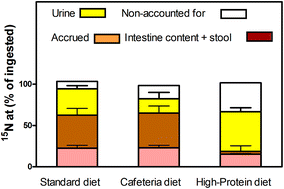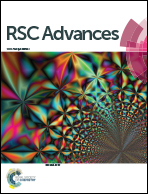Stable isotope analysis of dietary arginine accrual and disposal efficiency in male rats fed diets with different protein content†
Abstract
The administration of diets with different protein/energy ratios induce variable but distinctive responses in rats; an excessive protein content tends to decrease fat accumulation, but reversion of this ratio tends to increase adipose tissue mass. The fate of N derived from amino acid metabolism is not only dependent on energy and dietary protein; the increased excretion of urea elicited by high-protein diets contrasts with the lower urea excretion (despite excess dietary protein and energy) in rats fed a cafeteria diet. After one month of exposure to high-protein (HPD) or cafeteria (CD) diets, we administered a gavage of 15N-arginine to undisturbed adult male rats, in order to trace the utilization of this not-recyclable-N amino acid under diets with different protein/energy relationships. Rats fed a high-protein diet excreted higher amounts of N in urine and showed much lower gastrointestinal content of the label. The CD rats decreased the excretion of urine N. Both groups' N balance showed a significant proportion of N not-accounted-for (but excreted nevertheless), the proportion being especially large in the HPD group. In conclusion, the process of disposal of amino acid N through the so far unknown pathway for “non-accounted-for N” is, thus essentially dependent on excess amino acid availability; independently of urea cycle operation and diet energy content.



 Please wait while we load your content...
Please wait while we load your content...